May 30, 2018
In our recent review of the three primary meringue techniques -- French, Italian, and Swiss -- we helped you choose which method to use depending on the end result you hoped to achieve; and last week, we gave you a beautifully simple recipe for a matcha twist on the classic Eton Mess dessert, using the Swiss method.
Today, we have a fourth technique to share with you -- a hybrid, of sorts, between the Italian and French methods. It is a simplified “hot sugar method,” first popularized by the English chef and meringue master, Ottolenghi.
For this method, heat extra-fine sugar in a 400 degree oven for six minutes. Meanwhile, softly beat the aquafaba. When the sugar is ready, lower the mixer speed and spoon the hot sugar into the aquafaba. Because it’s been heated, the sugar will dissolve more easily than it does in the standard French method; but it is less involved than the sugar syrup process called for by the Italian method. In short, it is arguably the best of both worlds!
If you’re still feeling intimidated by the mystical meringue, this no-fuss recipe for French Meringues using the hot sugar method is just what you need!
French Meringue (Hot Sugar Method):
1 cup aquafaba (drained from about 1, 15oz can of chickpeas)
2/3 cup extra fine sugar
¼ tsp cream of tartar (optional)
½ tsp vanilla
Chef’s Tip: After it chills, it should jiggle like a soft jello. If it still pours easily, it will still make a soft meringue, but needs to be further reduced for a stiff meringue.
Chef’s Tip: You can make your own extra fine sugar by placing it in a blender on high speed. Pulse until you have a fine powder.
Chef Tip: For crisp meringues, allow the baked meringues to dry overnight in the oven with the pilot light on before storing.
Guest contributor, Jessica Serdikoff
Jessica has been driven all her life by a passion for food. Getting her informal start in her grandmother’s kitchen many years ago, she took a brief culinary hiatus to become a registered dietitian and certified personal trainer. Her curiosity and enthusiasm for food, recipe development, and kitchen creativity never left her, though, leading her most recently to graduate from the chef’s training program at the Natural Gourmet Institute of NYC. Now she has the know-how to geek out about food and the science behind it!
Chef, Diane Forley
Meringueshop founder and meringue-obsessed chef, always in search of new ways to use aquafaba.
Sign up for our newsletter
to stay up-to-date on new foods, holiday specials and gifts
